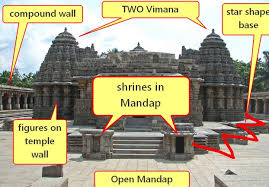Karnataka seeking World Heritage site status for Hoysala temples 12/11/2019 – Posted in: Daily News – Tags: UNESCO, World Heritage Sites
Hoysala temples
For: Preliminary & Mains
Topics covered:
- About Hoysala temples
- About the Hoysala Dynasty
- About Hoysala temple architecture
News Flash
The State Archaeology Department has clubbed 14 temples from the Hoysala period reflecting similar architectural styles — including the monuments at Belur-Halebid and Somnathpur — for serial nomination to seek UNESCO World Heritage Site status.
The final dossier is being prepared by the Indian National Trust for Art and Cultural Heritage (INTACH), Bengaluru, which is expected to submit it by April 2020.
Apart from the monuments at Belur and Halebid, the list includes Panchalingeshwara temple at Govindahall, Chennakeshava temple at Somnathpur, Kesava temple at Harnahalli, Lakshminarayana temple at Hosaholalu, Ishvara temple at Arsikere, Bucheshwara temple at Koravangala, Nageshwara and Chennakeshava temple at Mosale, Kalyani at Hulikere, Lakshmidevi temple at Doddagaddavalli, Amriteshwara temple at Amrutpura, and Viranarayana temple at Amrutpura.
There are 137 Hoysala temples of significant value in the State- 43 are protected by the Archaeological Survey of India, 55 by the Archaeology Department and the remaining 39 are unprotected. At present, Karnataka has Hampi and Pattadakal group of monuments inscribed World Heritage Sites.
Serial nominations
UNESCO defines serial nominations as any two or more unconnected sites that may contain a series of cultural or natural properties in different locations, provided that they are related because they belong to the same historical and cultural group. In India, forts at Chittorgarh, Kumbalgarh, Sawai Madhopur, Jaipur, Jhalawar and Jaisalmer are examples.
Hoysala Architecture
- Hoysala era (1026 CE -1343 CE) marked a prosperous span of art, architecture and culture.
- The nucleus of the activity lay in the present-day Hassan, Karnataka.
- They were originally from Malenadu used the opportunity to annex major territories in Southern India during the internal warfare between the Western Chalukyan Empire and the Kalachuris of Kalyani.
- They shifted the capital from Belur to Halebidu.
- Hoysala rulers were influenced by the Western Chalukyan architecture and employed their craftsmen as well.
- Hoysala rulers were the successors to the Chalukya dynasty in the Mysore plateau between 11th and 14th century AD. They were fond lovers of art and they were richly carved with a stellate/ high star-shaped base.
- Hoysala temples are sometimes called hybrid or vesara as their unique style seems neither completely Dravida nor Nagara, but somewhere in between.

Temple Architecture
- A cuboid cell, the garbha griha (sanctum sanctorum) houses a centrally placed murti (enshrined icon) on a pitha (pedestal).
- The shikhara (superstructure), rises over the garbha griha and togetherwith the sanctum they form the vimana (or mulaprasada) of a temple.
- A ribbed stone, amalaka, is placed atop the shikhara with a kalash at its finial.
- An intermediate antarala (vestibule) joins the garbha griha to an expansive pillared mandapa (porch) in front, chiefly facing east (or north).
- The temple may be approached via entrances with gigantic gopurams (ornate entrance towers) towering over each doorway.
- In the prakaram (temple courtyard) several minor shrines and outbuildings often abound.
Source: The Hindu
READ MORE DAILY NEWS
- India’s sovereign credit rating
- Lancet’s Global Burden of Disease Study
- Book ‘Courts of India: Past to Present’
- Public Service Broadcasting Day
- 550th birth anniversary of Guru Nanak Dev ji
- First all-electric plane
- World’s First CNG port terminal
You are on the Best Online IAS preparation platform. You are learning under experts.
We are present on Facebook- Diligent IAS, LinkedIn- Diligent IAS, YouTube- Diligent IAS, Instagram- Diligent IAS. Get in touch with us.

